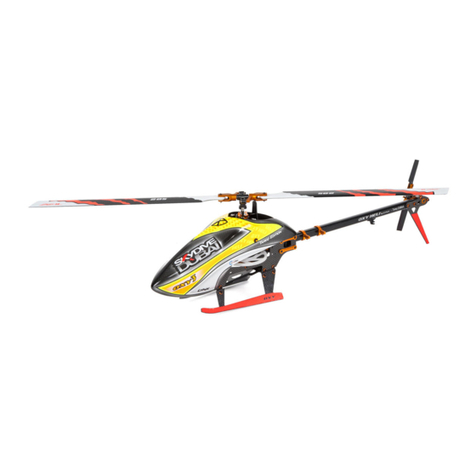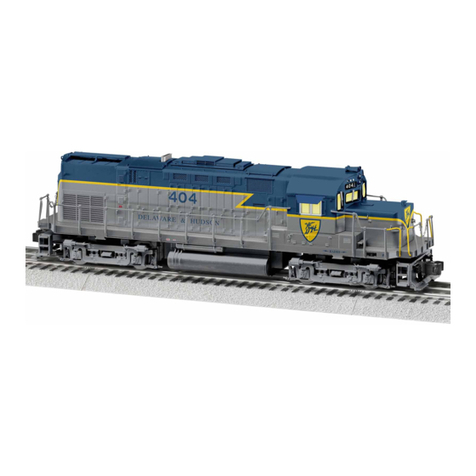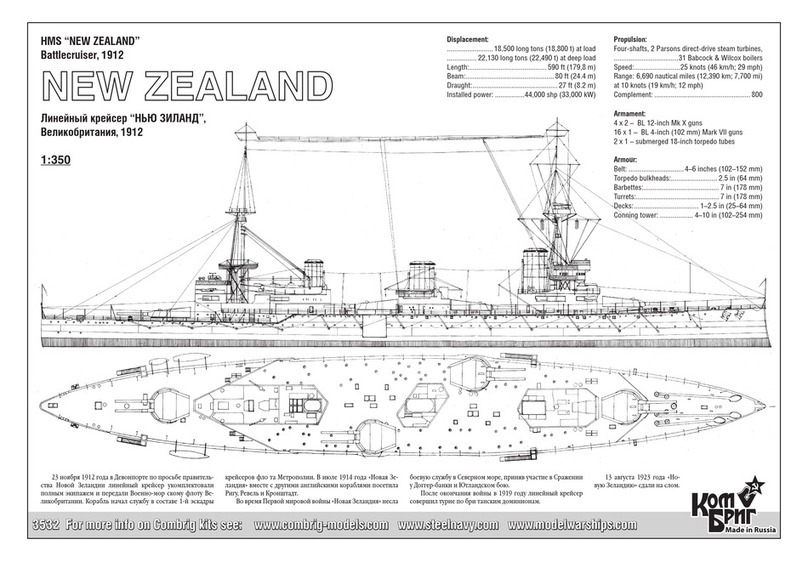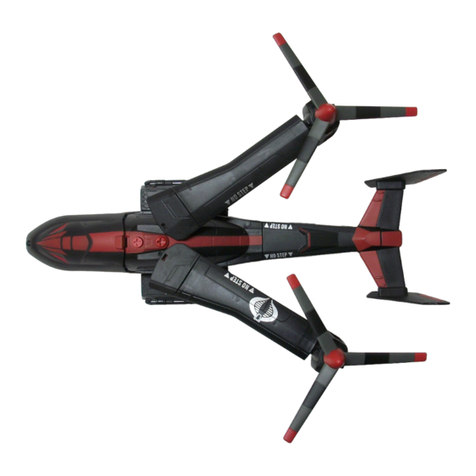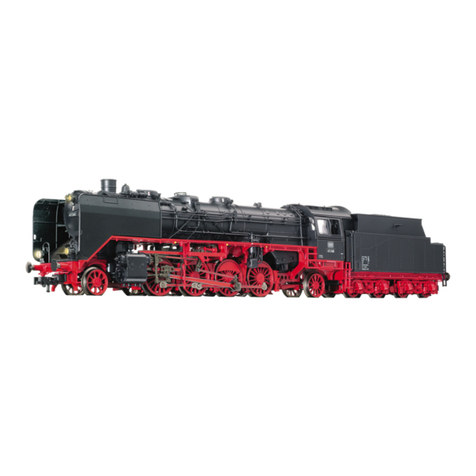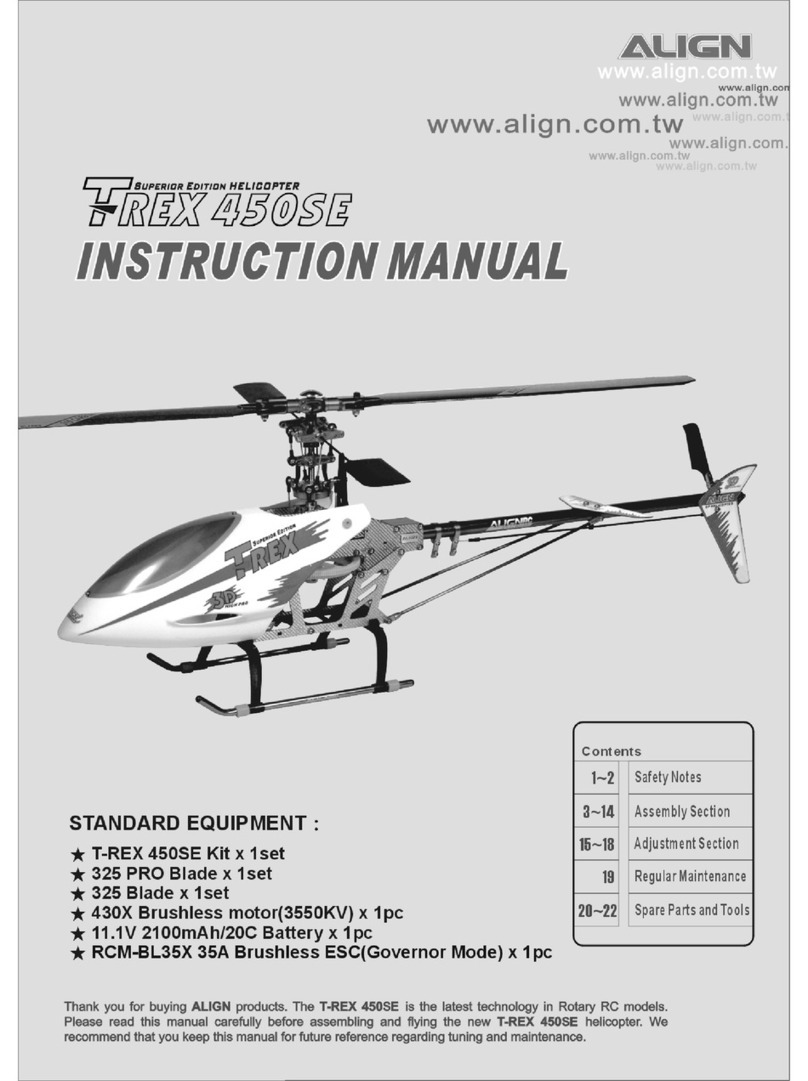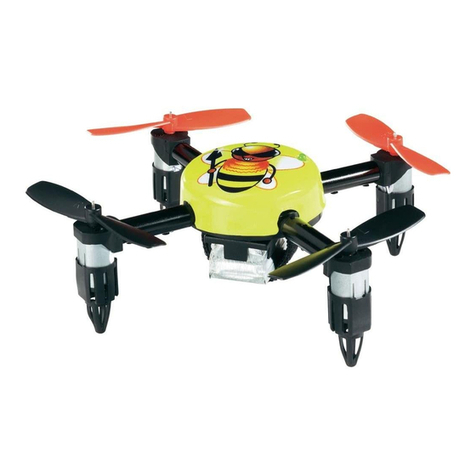electrifly L-39 User manual

Great Planes®Model Manufacturing Co. guarantees this kit to
be free from defects in both material and workmanship at the date
of purchase. This warranty does not cover any component parts
damaged by use or modification. In no case shall Great Planes’
liability exceed the original cost of the purchased kit. Further,
Great Planes reserves the right to change or modify this warranty
without notice.
In that Great Planes has no control over the final assembly or
material used for final assembly, no liability shall be assumed nor
accepted for any damage resulting from the use by the user of
the final user-assembled product. By the act of using the user-
assembled product, the user accepts all resulting liability.
If the buyer is not prepared to accept the liability associated
with the use of this product, the buyer is advised to return
this kit immediately in new and unused condition to the place
of purchase.
To make a warranty claim send the defective part or item to Hobby
Services at the address below:
Hobby Services
3002 N. Apollo Dr., Suite 1
Champaign, IL 61822 USA
Include a letter stating your name, return shipping address, as
much contact information as possible (daytime telephone number,
fax number, e-mail address), a detailed description of the problem
and a photocopy of the purchase receipt. Upon receipt of the
package, the problem will be evaluated as quickly as possible.
READ THROUGH THIS MANUAL BEFORE STARTING CONSTRUCTION. IT CONTAINS IMPORTANT
INSTRUCTIONS AND WARNINGS CONCERNING THE ASSEMBLY AND USE OF THIS MODEL.
Champaign, Illinois
(217) 398-8970, Ext 5
airsuppor[email protected]
WARRANTY
INSTRUCTION MANUAL
Entire Contents © Copyright 2008 GPMA6002MNL V1.0
Wingspan: 25 in [635mm]
Wing Area: 141 sq in [9.1 dm2]
Weight: 17.5–18.5 oz [500–520g]
Wing Loading: 17.9–18.9 oz/sq ft [55–58 g/dm2]
Length: 31 in [780mm]
Radio: 3-Channel Minimum and Micro Receiver
™

2
TABLE OF CONTENTS
INTRODUCTION ............................................................... 2
AMA .................................................................................. 2
SAFETY PRECAUTIONS ................................................. 2
LITHIUM BATTERY HANDLING AND USAGE ................ 3
RADIO EQUIPMENT......................................................... 3
ADDITIONAL ITEMS REQUIRED .................................... 3
Adhesives and Building Supplies............................... 3
Optional Supplies and Tools....................................... 3
IMPORTANT BUILDING NOTES ...................................... 4
ORDERING REPLACEMENT PARTS .............................. 4
KIT INSPECTION.............................................................. 5
KIT CONTENTS................................................................ 5
ASSEMBLE THE AIRPLANE ........................................... 6
GET THE MODEL READY TO FLY ................................... 8
Check the Control Directions ..................................... 8
Set the Control Throws .............................................. 9
Balance the Model (C.G.)........................................... 9
PREFLIGHT .................................................................... 10
Identify Your Model................................................... 10
Charge the Batteries ................................................ 10
Range Check ........................................................... 10
AMA SAFETY CODE (excerpts).................................... 10
CHECK LIST................................................................... 11
FLYING............................................................................ 11
Takeoff ..................................................................... 11
Flight ........................................................................ 11
Landing .................................................................... 11
INTRODUCTION
Welcome to the exciting world of EDF (Electric Ducted Fan)
airplanes!The L-39 is sure to please with its scale appearance
paired with the convenience of being constructed from light
weight foam. In addition, the L-39 also includes a painted
stand and removable missiles and drop tanks (for display
only) that will allow the plane to double as a display model.
Using the included brushless motor, the L-39 achieves
incredible speeds, being clocked at 78 mph coming out of a
dive! The L-39 is a great, stable flyer too and can comfortably
fly at slower speeds.
For the latest technical updates or manual corrections
to the L-39 RXR visit the Great Planes web site at www.
greatplanes.com. Open the “Airplanes” link, then select the
L-39 RXR. If there is new technical information or changes
to this model a “tech notice” box will appear in the upper left
corner of the page.
AMA
We urge you to join the AMA (Academy of Model Aeronautics)
and a local R/C club.The AMA is the governing body of model
aviation and membership is required to fly at AMA clubs.
Though joining the AMA provides many benefits, one of the
primary reasons to join is liability protection. Coverage is not
limited to flying at contests or on the club field. It even applies
to flying at public demonstrations and air shows. Failure to
comply with the Safety Code (excerpts printed in the back of
the manual) may endanger insurance coverage. Additionally,
training programs and instructors are available at AMA club
sites to help you get started the right way. There are over
2,500 AMA chartered clubs across the country. Contact the
AMA at the address or toll-free phone number below.
Academy of Model Aeronautics
5151 East Memorial Drive
Muncie, IN 47302
Tele: (800) 435-9262
Fax (765) 741-0057
Or via the Internet at:
http://www.modelaircraft.org
IMPORTANT!!! Two of the most important things you can do
to preserve the radio controlled aircraft hobby are to avoid
flying near full-scale aircraft and avoid flying near or over
groups of people.
PROTECT YOUR MODEL, YOURSELF
& OTHERS...FOLLOW THESE
IMPORTANT SAFETY PRECAUTIONS
1. Your L-39 RXR should not be considered a toy, but rather
a sophisticated, working model that functions very much like
a full-size airplane. Because of its performance capabilities,
the L-39, if not assembled and operated correctly, could
possibly cause injury to yourself or spectators and damage
to property.
2.You must assemble the model according to the instructions.
Do not alter or modify the model, as doing so may result in
an unsafe or unflyable model. In a few cases the instructions
may differ slightly from the photos. In those instances the
written instructions should be considered as correct.
3. You must take time to build straight, true and strong.
4. You must correctly install all R/C and other components
so that the model operates correctly on the ground and in
the air.

3
5. You must check the operation of the model before every
flight to insure that all equipment is operating and that the
model has remained structurally sound. Be sure to check
pushrod connectors or servo arms often and replace them if
they show any signs of wear or fatigue.
6. If you are not an experienced pilot or have not flown
this type of model before, we recommend that you get the
assistance of an experienced pilot in your R/C club for
your first flights. If you’re not a member of a club, your local
hobby shop has information about clubs in your area whose
membership includes experienced pilots.
We, as the kit manufacturer, provide you with a top quality,
thoroughly tested kit and instructions, but ultimately the
quality and flyability of your finished model depends
on how you build it; therefore, we cannot in any way
guarantee the performance of your completed model,
and no representations are expressed or implied as to
the performance or safety of your completed model.
Remember:Take your time and follow the instructions to
end up with a well-built model that is straight and true.
LITHIUM BATTERY
HANDLING & USAGE
WARNING!! Read the entire instruction sheet included with
the battery. Failure to follow all instructions could cause
permanent damage to the battery and its surroundings, and
cause bodily harm!
• ONLY use a LiPo approved charger. NEVER use a NiCd/
NiMH peak charger!
• NEVER charge in excess of 4.20V per cell.
• ONLY charge through the “charge” lead. NEVER charge
through the “discharge” lead.
• NEVER charge at currents greater than 1C.
• ALWAYS set charger’s output volts to match battery volts.
• ALWAYS charge in a fireproof location.
• NEVER trickle charge.
• NEVER allow battery temperature to exceed 150° F (65° C).
• NEVER disassemble or modify pack wiring in any way or
puncture cells.
• NEVER discharge below 2.5V per cell.
• NEVER place on combustible materials or leave unattended
during charge or discharge.
• ALWAYS KEEP OUT OF REACH OF CHILDREN.
RADIO EQUIPMENT
The L-39 EDF RXR requires a 3+ channel transmitter and a
micro receiver. If you already have a transmitter you are going
to use to fly the L-39, you can get the receiver separately:
❏ Futaba R617FS FASST™Receiver (FUTL7627)
-or-
❏Futaba®R114F 4-Channel FM Micro Receiver w/o Crystal
(Low Band: FUTL0442; High Band: FUTL0443)
❏Futaba FM Single conversion receiver crystal for R114F
(Low Band: FUTL62**; High Band: FUTL63**)
A lithium-polymer battery pack and suitable charger are
also required. Although there are different battery packs
and chargers available that will work with the L-39 RXR, the
economical choices recommended by Great Planes are:
❏Great Planes LiPo 11.1V 910mAh 20C Discharge
w/Balance (GPMP0605)
❏Great Planes LiPo 11.1V 1250mAh 20C Discharge
w/Balance (GPMP0609)
❏Great Planes ElectriFly DC peak charger (GPMM3010)
❏Great Planes Equinox™Cell Balancer (GPMM3160)
Note: Battery choice will affect the balance of the plane. The
1250mAh pack will result in a forward C.G. position, and the
910mAh pack will provide a more aft C.G. position.
ADDITIONAL ITEMS REQUIRED
Adhesives and Building Supplies
Foam safe CA glue and 30-minute epoxy are used in the
assembly of the L-39 RXR. Order numbers are provided
below.
❏Great Planes Pro™Epoxy 30-Minute Formula 4 oz.
(GPMR6043)
❏Great Planes Pro Foam Safe CA- Thick Glue 1 oz.
(GPMR6072)
❏Denatured alcohol (for epoxy clean up)
Optional Supplies and Tools
Here is a list of items that will help you build the L-39 RXR.
❏CA debonder (GPMR6039)
❏Epoxy brushes (6, GPMR8060)
❏Mixing sticks (50, GPMR8055)
❏Mixing cups (GPMR8056)
❏CG Machine™(GPMR2400)
❏Hobbico®Flexible 18" Ruler Stainless Steel (HCAR0460)

IMPORTANT BUILDING NOTES
• When you see the term test fit in the instructions, it means
that you should first position the part on the assembly
without using any glue, then slightly modify or custom fit
the part as necessary for the best fit.
• Whenever the term glue is written you should rely upon
your experience to decide what type of glue to use. When
a specific type of adhesive works best for that step, the
instructions will make a recommendation.
• Whenever just epoxy is specified you may use either
30-minute (or 45-minute) epoxy or 6-minute epoxy. When
30-minute epoxy is specified it is highly recommended that
you use only 30-minute (or 45-minute) epoxy, because you
will need the working time and/or the additional strength.
• Photos and sketches are placed before the step they
refer to. Frequently you can study photos in following steps
to get another view of the same parts.
ORDERING REPLACEMENT PARTS
Replacement parts for the L-39 RXR are available using the
order numbers in the Replacement Parts List that follows. The
fastest, most economical service can be provided by your
hobby dealer or mail-order company.
To locate a hobby dealer, visit the Great Planes web site
at www.greatplanes.com. Choose “Where to Buy” at the
bottom of the menu on the left side of the page. Follow the
instructions provided on the page to locate a U.S., Canadian
or International dealer.
Parts may also be ordered directly from Hobby Services by
calling (217) 398-0007, or via facsimile at (217) 398-7721,
but full retail prices and shipping and handling charges will
apply. Illinois and Nevada residents will also be charged
sales tax. If ordering via fax, include a Visa®or MasterCard®
number and expiration date for payment.
Mail parts orders and payments by personal check to:
Hobby Services
3002 N. Apollo Drive, Suite 1
Champaign, IL 61822
Be certain to specify the order number exactly as listed in
the Replacement Parts List. Payment by credit card or
personal check only; no C.O.D.
If additional assistance is required for any reason, contact
Product Support by telephone at (217) 398-8970, or by
Replacement Parts List
Order Number Description How to Purchase
Missing pieces ............... Contact Product Support
Instruction manual.......... Contact Product Support
Full-size plans ................................... Not available
Contact your hobby supplier for the following parts:
GPMA2772........... Wing Set with Tip Tanks
GPMA2773........... Fuse Kit with Hatch
GPMA2774 ........... Tail Set
GPMA2775 ........... Canopy Hatch
GPMA2776 ........... Armament Set
GPMA2777 ........... Display Stand
GPMA2778 ........... Tip Tanks (2)
GPMA2779 ........... Decal Sheet
GPMA2795........... Canopy with Pilot Figures
GPMA3124........... Motor Lead Extension
GPMG3900........... HyperFlow Ducted Fan Unit
GPMG3940........... Ducted Fan Rotor Blade
GPMG3941........... Ducted Fan Miscellaneous Parts
GPMG3942........... Ducted Fan Outer Duct
GPMG3943........... Ducted Fan Adapter
GPMM1210 ..........ES50 Nano Servo
GPMM1820 ..........SS25 Brushless 25A ESC
4

5
KIT INSPECTION
Before starting to build, inspect the parts to make sure they are of acceptable quality. If any parts are missing or are not
of acceptable quality, or if you need assistance with assembly, contact Product Support. When reporting defective or
missing parts, use the part names exactly as they are written in the Kit Contents list.
Great Planes Product Support
3002 N. Apollo Drive, Suite 1
Champaign, IL 61822
Telephone: (217) 398-8970, ext. 5
Fax: (217) 398-7721
E-mail: airsuppor[email protected]
KIT CONTENTS
1. Fuselage
2. Ducted Fan Access Hatch
3. Wing w/Ailerons
4. Horizontal Stabilizer w/Elevators
5. Vertical Fin
6. Clear Canopy Hatch
7. Drop Tanks (2)
8. Missiles (2)
9. Wing Tip Tanks (2)
10. Canopy Hatch
11. Servo Horn Cover (2)
1
6
2
5
4
9
10
11
8
7
3

6
6
6
ASSEMBLE THE AIRPLANE
❏1. Position the motor lead extensions into the slot in the
fuselage, down the channel in the wing saddle, and through
the hole to the radio compartment.
❏2. Attach the included Y-harness to the aileron servo leads.
❏3. Coat the wing saddle on the fuselage with 30-minute
epoxy. Insert the aileron servo wires through the hole in the
fuse and into the radio compartment. Place the wing onto the
saddle by fitting the alignment keys on the top of the wing
into the mating cutouts in the wing saddle. Tape the wing to
the fuse while the epoxy cures or place a weight on the top
of the fuse to press it against the wing. If using tape, avoid
damaging the paint by first lining the outside of the model with
sheets of paper or something similar. Wrap the tape tightly
around the paper instead of directly onto the model.
❏4. The vertical fin and horizontal stabilizer are keyed to fit
together and therefore must be glued in place at the same
time. Coat with epoxy the key on the bottom of the fin, the
slot in the horizontal stabilizer, and the stab saddle on the
fuselage. Do not put epoxy on the foam piece glued to
the front of the fin that fits into the ducted fan access
hatch! Position the parts onto the fuselage, making sure
that the vertical fin is being glued square to the horizontal
stabilizer. The parts can be taped or held in place while the
epoxy cures.

7
❏5. Attach the elevator pushrod to the outer hole in the elevator
control horn and secure it using the 90° pushrod connector.
❏6. Connect the ESC to the motor lead extensions and
connect the servos and ESC to your receiver. This is a good
time to confirm the correct rotation of your ducted fan unit.If the
unit rotates the wrong direction when powered up, disconnect
two of the three motor leads and swap their positions.
❏7. Feed the receiver antenna through the antenna tube
and out the back of the fuselage. Use the included double-
sided tape to secure the ESC and receiver to the side of the
radio compartment. Be sure they are positioned at the back
of the compartment and that the wires are tucked neatly out
of the way.
❏8. Apply the hook side of the included hook and loop
material to the bottom of the radio compartment. Brushing
on a thin coat of epoxy and letting it cure before attaching the
hook material will help it adhere to the foam. Apply the loop
side to your battery pack.
❏9. Assemble and glue the display stand together as shown
using foam-safe glue. The long slots in the two large pieces
interlock and the four cross braces are glued into the small slots.

8
❏10. Finish the model by test fitting the removable drop tanks
and missiles to the underside of the wing. These parts are
attached magnetically and are for display purposes only. Be
sure to remove them prior to flight! The included clear canopy
hatch is also recommended for display purposes only.
GET THE MODEL READY TO FLY
Check the Control Directions
❏1. Turn on the transmitter and receiver and center the trims.
❏2. With the transmitter and receiver still on, check all the
control surfaces to see if they are centered. If necessary,
loosen the knurled thumb screws in the screw-lock pushrod
connectors and adjust the pushrods until the control surfaces
are centered. When satisfied, re-tighten the thumb screws
using a flat head screwdriver.
ELEVATORS MOVE UP
RIGHT AILERON MOVES UP
LEFT AILERON MOVES DOWN
FULL THROTTLE
3-CHANNEL RADIO SETUP
(STANDARD MODE 2)
❏3. Make certain that the control surfaces and the throttle
respond in the correct direction as shown in the diagram.
If any of the controls respond in the wrong direction, use
the servo reversing in the transmitter to reverse the servos
connected to those controls. Be certain the control surfaces
have remained centered. Adjust if necessary.
❏4. If the ESC makes continued low-pitched beeps when
the transmitter is turned on and the throttle stick is in the
idle position, then the throttle channel is reversed in the
transmitter.
❏5. The SS-25 brushless ESC is equipped with a safety
feature that prevents the motor from rotating before the ESC
has been armed. To arm the ESC, turn the transmitter on
and move the throttle stick to idle. Plug the battery into the
ESC. Move the throttle stick to full throttle until you hear a
beep. Move the throttle stick back to the idle position and you
will hear two beeps. The ESC is now armed.
❏6. The SS-25 brushless ESC is equipped with a “brake”
feature.To toggle the brake on and off, turn the transmitter on
and move the throttle stick to full throttle. Plug the battery into
the ESC. You will hear two quick beeps after a few seconds.
Move the throttle stick to the idle position. Continue with the
arming procedure as described in step 5.
❏7. To download the complete SS-25 brushless ESC
manual, visit www.greatplanes.com.

9
Set the Control Throws
Use a Great Planes AccuThrow™(or a ruler) to accurately
measure and set the control throw of each control surface
as indicated in the chart that follows. If your radio does not
have dual rates, we recommend setting the throws at the
low rate setting.
These are the recommended control surface throws:
ELEVATOR (High Rate): 5/16" [8mm], 10° up
5/16" [8mm], 10° down
AILERONS (High Rate): 3/16" [4.8mm], 8° up
3/16" [4.8mm], 8° down
ELEVATOR (Low Rate): 1/8" [3.2mm], 4° up
1/8" [3.2mm], 4° down
AILERONS (Low Rate): 3/32" [2.4mm], 4° up
3/32" [2.4mm], 4° down
NOTE: The throws are measured at the widest part of
the control surfaces.
IMPORTANT: The L-39 RXR has been extensively flown
and tested to arrive at the throws at which it flies best. Flying
your model at these throws will provide you with the greatest
chance for successful first flights. If, after you have become
accustomed to the way the L-39 RXR flies, you would like
to change the throws to suit your taste, that is fine. However,
too much control throw could make the model difficult to
control, so remember, “more is not always better.”
Balance the Model (C.G.)
More than any other factor, the C.G. (balance point)
can have the greatest effect on how a model flies, and
may determine whether or not your first flight will be
successful. If you value this model and wish to enjoy it for
many flights, DO NOT OVERLOOK THIS IMPORTANT
PROCEDURE. A model that is not properly balanced will
be unstable and possibly unflyable.
At this stage the model should be in ready-to-fly condition
with all of the systems in place including the receiver, ESC,
and battery pack.
❏1. The C.G. is located 1-15/16" [49mm] back from
the leading edge of the wing at the fuselage (the seam
where the wing panels have been joined to the fuselage).
If you mark the C.G. position onto the top of the wing, be
very careful if using tape as it could damage the paint when
removed. Also, do not attempt to remove felt-tip pen marks
with alcohol. We suggest making small marks on the wing
beneath the ducted fan inlets.
This is where your model should balance for the first
flights. Later, you may wish to experiment by shifting the
C.G. up to 3/16" [4.8mm] forward or 1/8" [3.2mm] back to
change the flying characteristics. Moving the C.G. forward
may improve the smoothness and stability, but the model
may be more difficult to slow for landing. Moving the C.G.
aft makes the model more maneuverable, but could also
cause it to become too difficult to control. In any case,
start at the recommended balance point and do not at
any time balance the model outside the specified range.
❏2. With all parts of the model installed (ready to fly), place
the model upside-down on a Great Planes CG Machine, or
lift it upside down at the balance point you marked.
❏3. If the tail drops, the model is “tail heavy” and the
battery pack and/or receiver must be shifted to balance. If
the nose drops, the model is “nose heavy” and the battery
pack and/or receiver must be shifted to balance. This model
is very weight sensitive. We do not recommend adding any

10
additional weight to achieve the suggested balance point
unless absolutely necessary. Instead, shift the battery pack
and receiver forward or aft to alter the C.G.
PREFLIGHT
Identify Your Model
No matter if you fly at an AMA sanctioned R/C club site or
if you fly somewhere on your own, you should always have
your name, address, telephone number and AMA number
on or inside your model. It is required at all AMA R/C club
flying sites and AMA sanctioned flying events. Fill out the
identification tag on the back cover of this manual and place it
on or inside your model.
Charge the Batteries
Follow the battery charging instructions that came with your
radio control system to charge the batteries. You should
always charge your transmitter and motor batteries the night
before you go flying, and at other times as recommended by
the manufacturer.
CAUTION: Unless the instructions that came with your
radio system state differently, the initial charge on new
transmitter batteries should be done for 15 hours using
the slow-charger that came with the radio system.
This will “condition” the batteries so that the next charge
may be done using the fast-charger of your choice. If the
initial charge is done with a fast-charger the batteries
may not reach their full capacity and you may be flying
with batteries that are only partially charged.
Range Check
Ground check the operational range of your radio before the
first flight of the day. With the transmitter antenna collapsed
and the receiver and transmitter on, you should be able to
walk at least 100 feet away from the model and still have
control. Have an assistant stand by your model and, while
you work the controls, tell you what the control surfaces are
doing. Repeat this test with the motor running at various
speeds with an assistant holding the model, using hand
signals to show you what is happening. If the control surfaces
do not respond correctly, do not fly! Find and correct the
problem first. Look for loose servo connections or broken
wires, corroded wires on old servo connectors, poor solder
joints in your battery pack or a defective cell, or a damaged
receiver crystal from a previous crash.
AMA SAFETY CODE (excerpts)
Read and abide by the following excerpts from the Academy
of Model Aeronautics Safety Code. For the complete Safety
Code refer to Model Aviation magazine, the AMA web site or
the Code that came with your AMA license.
General
1) I will not fly my model aircraft in sanctioned events, air
shows, or model flying demonstrations until it has been
proven to be airworthy by having been previously,
successfully flight tested.
2) I will not fly my model aircraft higher than approximately
400 feet within 3 miles of an airport without notifying the
airport operator. I will give right-of-way and avoid flying
in the proximity of full-scale aircraft. Where necessary,
an observer shall be utilized to supervise flying to avoid
having models fly in the proximity of full-scale aircraft.
3) Where established, I will abide by the safety rules for the
flying site I use, and I will not willfully and deliberately fly my
models in a careless, reckless and/or dangerous manner.
5) I will not fly my model unless it is identified with my name
and address or AMA number, on or in the model. Note:
This does not apply to models while being flown indoors.
7) I will not operate models with pyrotechnics (any device
that explodes, burns, or propels a projectile of any kind).
Radio Control
1) I will have completed a successful radio equipment ground
check before the first flight of a new or repaired model.
2) I will not fly my model aircraft in the presence of spectators
until I become a qualified flier, unless assisted by an
experienced helper.
3) At all flying sites a straight or curved line(s) must be
established in front of which all flying takes place with the
other side for spectators. Only personnel involved with
flying the aircraft are allowed at or in the front of the flight
line. Intentional flying behind the flight line is prohibited.
4) I will operate my model using only radio control frequencies
currently allowed by the Federal Communications Commission.
5) I will not knowingly operate my model within three miles
of any pre-existing flying site except in accordance with
the frequency sharing agreement listed [in the complete
AMA Safety Code].
9) Under no circumstances may a pilot or other person touch
a powered model in flight; nor should any part of the
model other than the landing gear, intentionally touch
the ground, except while landing.

11
CHECK LIST
During the last few moments of preparation your mind may
be elsewhere anticipating the excitement of the first flight.
Because of this, you may be more likely to overlook certain
checks and procedures that should be performed before
the model is flown.To help avoid this, a check list is provided
to make sure these important areas are not overlooked.
Many are covered in the instruction manual, so where
appropriate, refer to the manual for complete instructions.
Be sure to check the items off as they are completed.
❏1. Check the C.G. according to the measurements provided
in the manual.
❏2. Be certain the battery and receiver are securely mounted
in the fuse.
❏3. Confirm that all controls operate in the correct direction
and the throws are set up according to the manual.
❏4. Check the operation of the ducted fan unit prior to
each flight.
❏5. Make sure that all servo arms are secured to the servos
wtih the screws included with your radio.
❏6. Place your name, address, AMA number and telephone
number on or inside your model.
❏7. If you wish to photograph your model, do so before your
first flight.
❏8. Range check your radio when you get to the flying field.
FLYING
IMPORTANT:If you are an inexperienced modeler we strongly
urge you to seek the assistance of a competent, experienced
R/C pilot to check your model for airworthiness AND to teach
you how to fly. No matter how stable or “forgiving” the L-39 is,
attempting to learn to fly on your own is dangerous and may
result in destruction of your model or even injury to yourself
and others. Therefore, find an instructor and fly only under
his or her guidance and supervision until you have acquired
the skills necessary for safe and fully controlled operation of
your model.
Takeoff
Less-experienced flyers should fly the L-39 only in calm
(less than five miles per hour) conditions. Frequently, winds
are calm in the early morning and early evening. Often these
are the most enjoyable times to fly anyway!
Until you have the L-39 properly trimmed for level flight, we
recommend having an assistant hand-launch the model
instead of launching it yourself.
Turn on the transmitter and plug the battery into the speed
control. Secure the canopy hatch in place.
IMPORTANT: Confirm that the transmitter operates the
controls properly by moving the sticks and watching the
surfaces respond.
When ready to launch, the assistant should hold the L-39
behind the canopy hatch, with the model in front of him and
pointed into the wind. With the pilot (that would be you!)
standing behind the plane, fully advance the throttle to start
the motor. When the motor is at full power, the hand launcher
should firmly give the model an underhand toss into the air
with a slightly nose-up attitude. Be certain the model is being
launched into the wind and be immediately ready to make
corrections to keep the airplane flying straight, level and into
the wind.
When the model has gained adequate flying speed under
its own power, gently pull the elevator stick back until the
airplane starts a gradual climb. Many beginners tend to pull
too hard causing the model to stall, so be gentle on the
elevator and don’t panic. If you do pull too hard and you
notice the model losing speed, release the elevator stick and
allow the model to regain airspeed.
Continue a gradual climb and establish a gentle turn (away
from yourself and others) until the airplane reaches an
altitude of 20 to 30 meters [75 to 100 feet].
Flight
The main purpose of the first few flights is to learn how the
model behaves and to adjust the trims for level flight. After the
model has climbed to a safe altitude, reduce the throttle slightly
to slow the model, yet maintain altitude. The L-39 should fly
well and maintain adequate airspeed at about 1/2 throttle.
Adjust the elevator trim so the model flies level at the throttle
setting you are using.Adjust the aileron trim to level the wings.
It may take a few minutes to get the trims adjusted, but this
should be your first priority once at a comfortable altitude.
Continue to fly around, executing turns and making mental
notes (or having your assistant take notes for you) of what
additional adjustments or C.G. changes may be required to
fine tune the model so it flies the way you like.
Landing
Begin the landing approach by flying downwind at an altitude
of approximately 6 meters [20 feet]. When the airplane is
approximately 15 to 30 meters [50 to 100 feet] past you,
gradually reduce power and make the “final” 180° turn into
the wind aligning the airplane with the runway or landing
area. Do not dive the airplane, as it will pick up too much
speed. Instead, allow the airplane to establish a gradual
descent. Concentrate on keeping it heading into the wind
toward the runway. When the plane reaches an altitude of
about 1 meter [3 feet], gently apply a little “up elevator” to
level the plane, but be careful as too much up elevator will

cause it to stall. While holding a slight amount of up elevator
the airplane will slow and descend as it loses flying speed,
thus touching-down on the runway. Be sure to throttle back to
idle to prevent the ducted fan from sucking in debris.
Until you are able to accurately judge how far the L-39 can
glide, it may be helpful to reserve some battery power to run
the motor so the plane can be flown back to the runway.
Best of luck and happy flying!
Make a copy of this identification tag and put it on or
inside your model.
ALSO AVAILABLE FROM GREAT PLANES
ElectriFly Equinox™LiPo Cell Balancer
By regulating the voltage levels from 2 to 5 LiPo cells to within
a very tight tolerance of each other, the Equinox ensures the
fullest possible safe voltage during charging – which means
more power and longer lasting packs! It can handle a maximum
current of 3 amps during charge or discharge (up to 6 amps
with custom connectors), and includes adapters for 2S and 3S
(7.4V & 11.1V) batteries and gold-plated banana plugs. Plus,
it automatically checks for poor quality cells, and provides a
safe platform for charging*. Choose from two modes for using
Equinox: connected directly to the cell in “Quick Balance”
mode, or in conjunction with a LiPo-compatible charger/
discharge in “Interface” mode. GPMM3160
*Equinox cannot be used with LiPo batteries which have built-in charge
protection circuits.
ElectriFly PolyCharge4™
For convenience with multiple LiPo packs, there’s the DC
PolyCharge4. Each of its four independent outputs can
charge a one-to-four cell Lithium-Polymer pack. It’s ideal if
you don’t have the time for one-at-a-time charging – and
don’t want the expense and hassle of multiple chargers.
Each output can handle packs from 300 to 3000mAh. Set the
capacity, and PolyCharge4 will automatically set the charge
rate to get you started – and use light and sound cues to tell
you when your pack is done. GPMM3015
Table of contents
Other electrifly Toy manuals
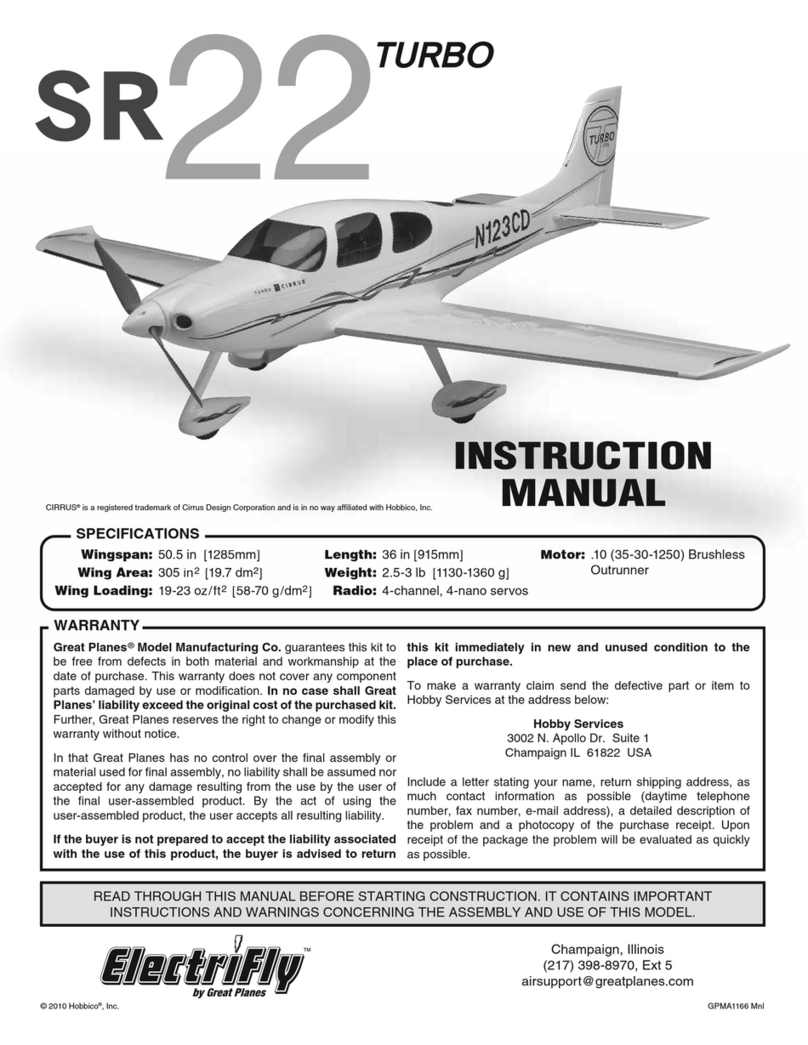
electrifly
electrifly SR22Turbo User manual
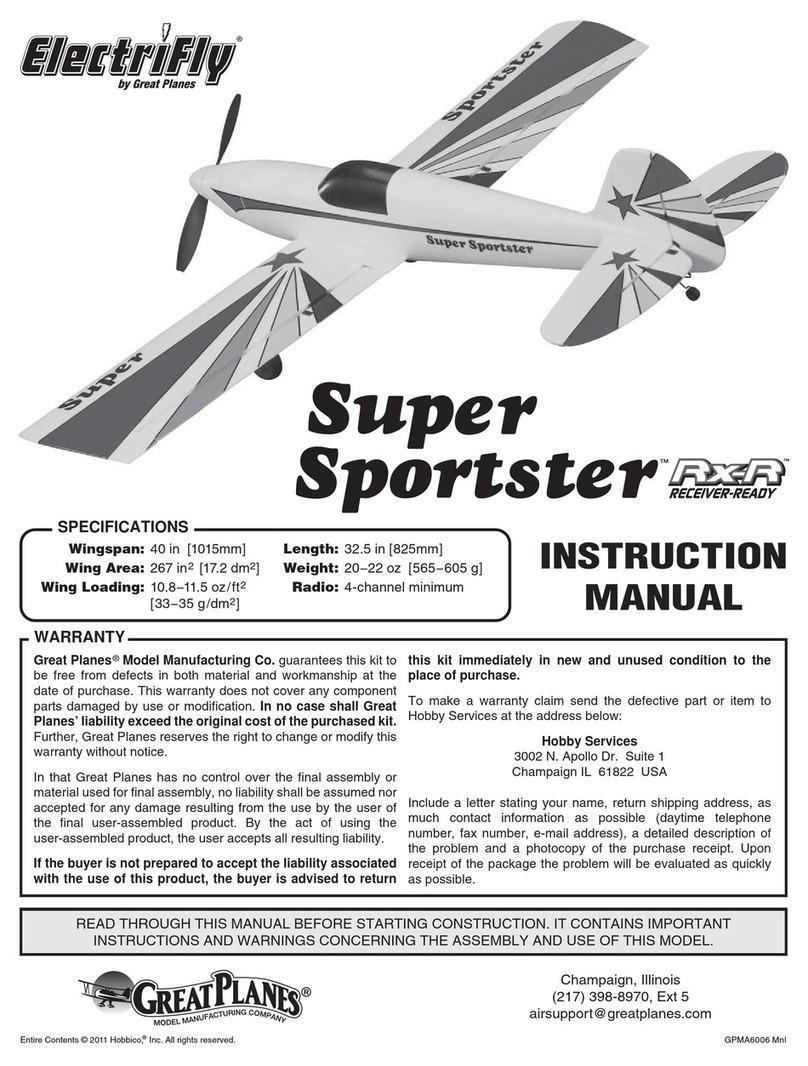
electrifly
electrifly Super Sportster RX-R User manual
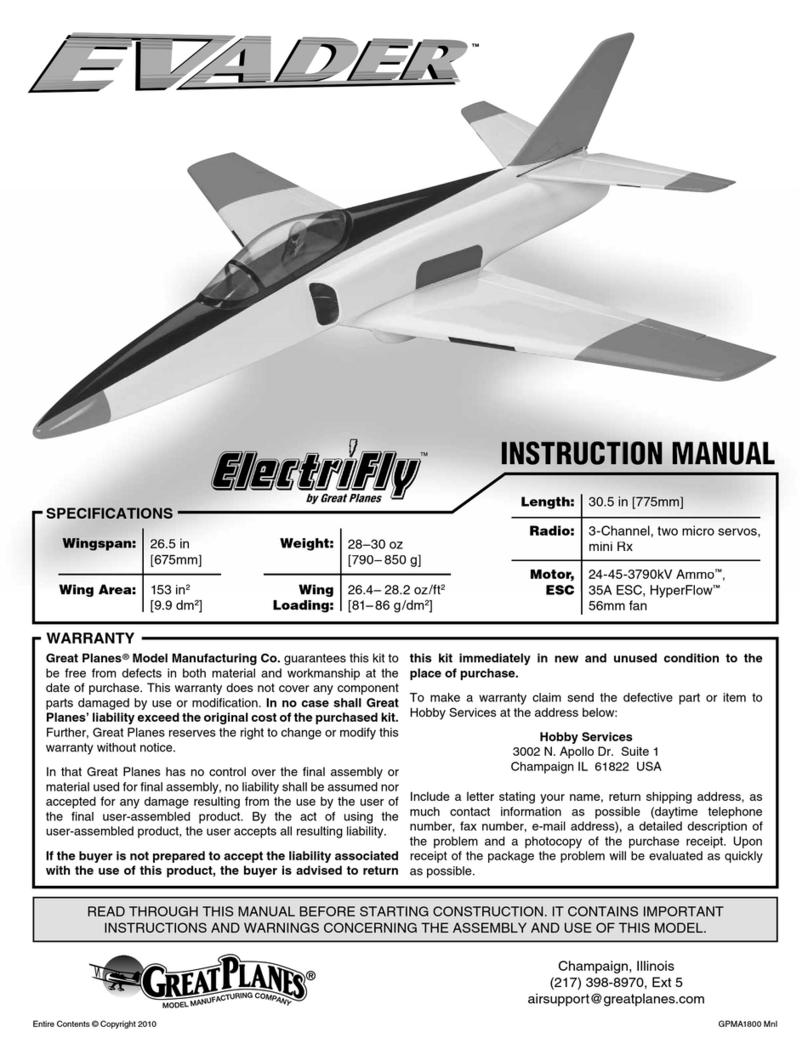
electrifly
electrifly ElectriFly User manual
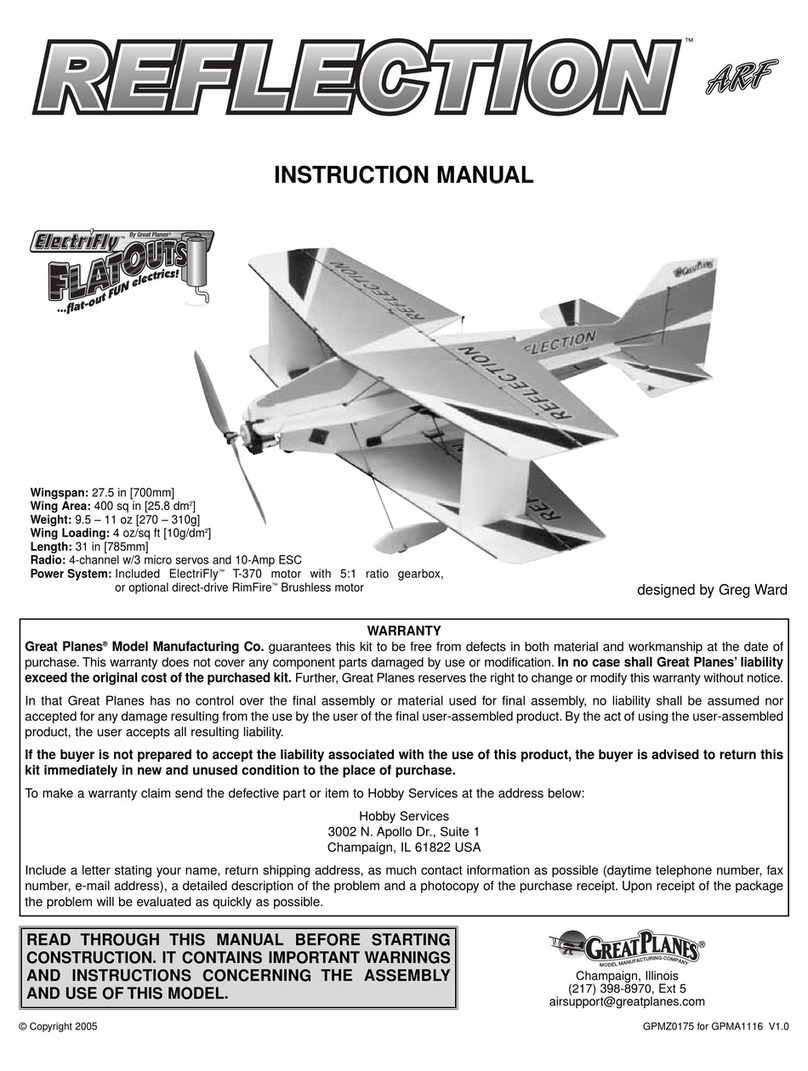
electrifly
electrifly reflection User manual
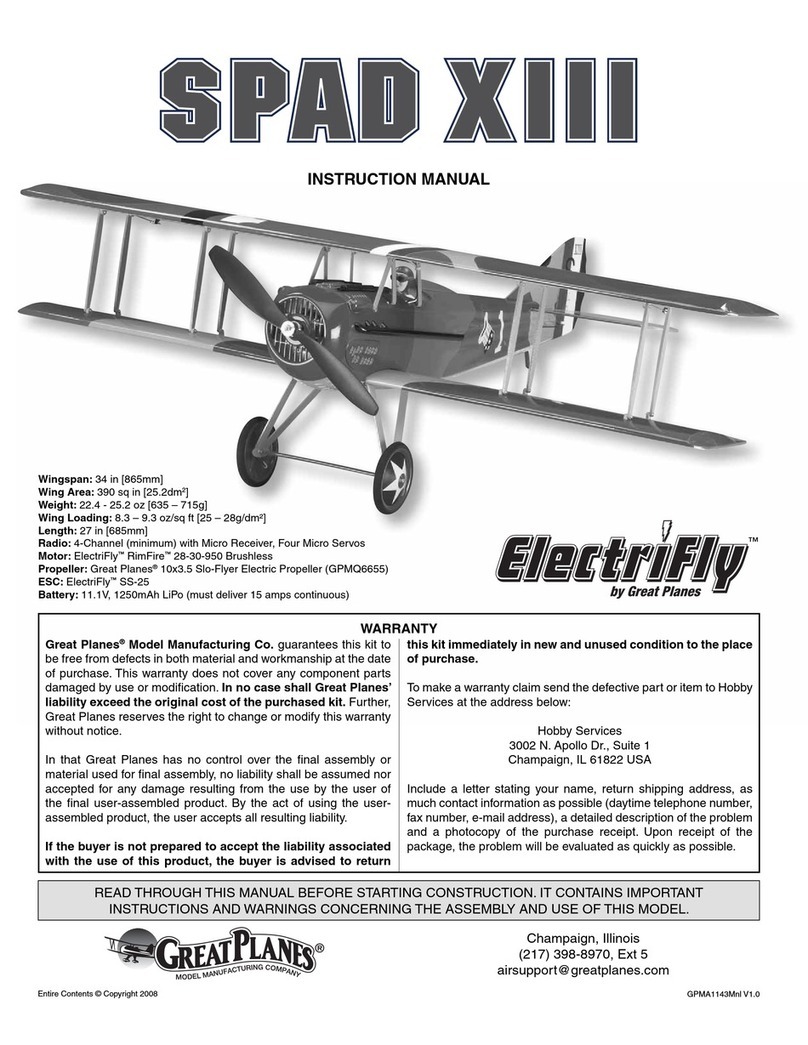
electrifly
electrifly Spad XIII User manual
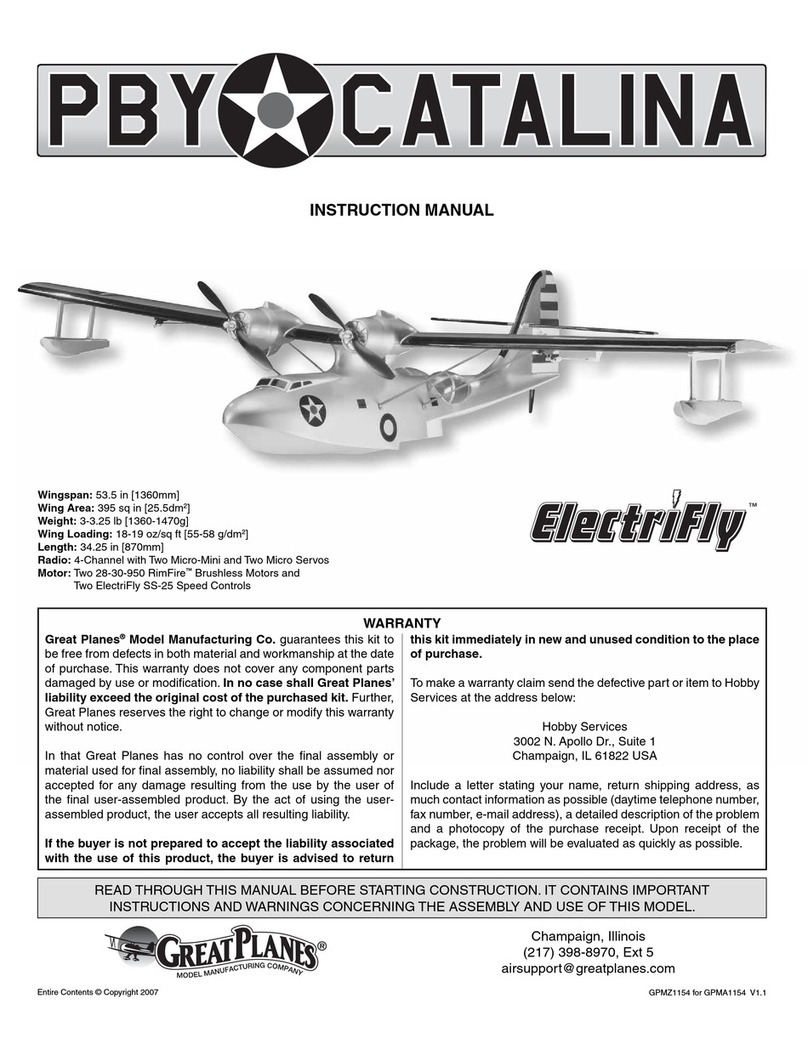
electrifly
electrifly PBY CATALINA User manual
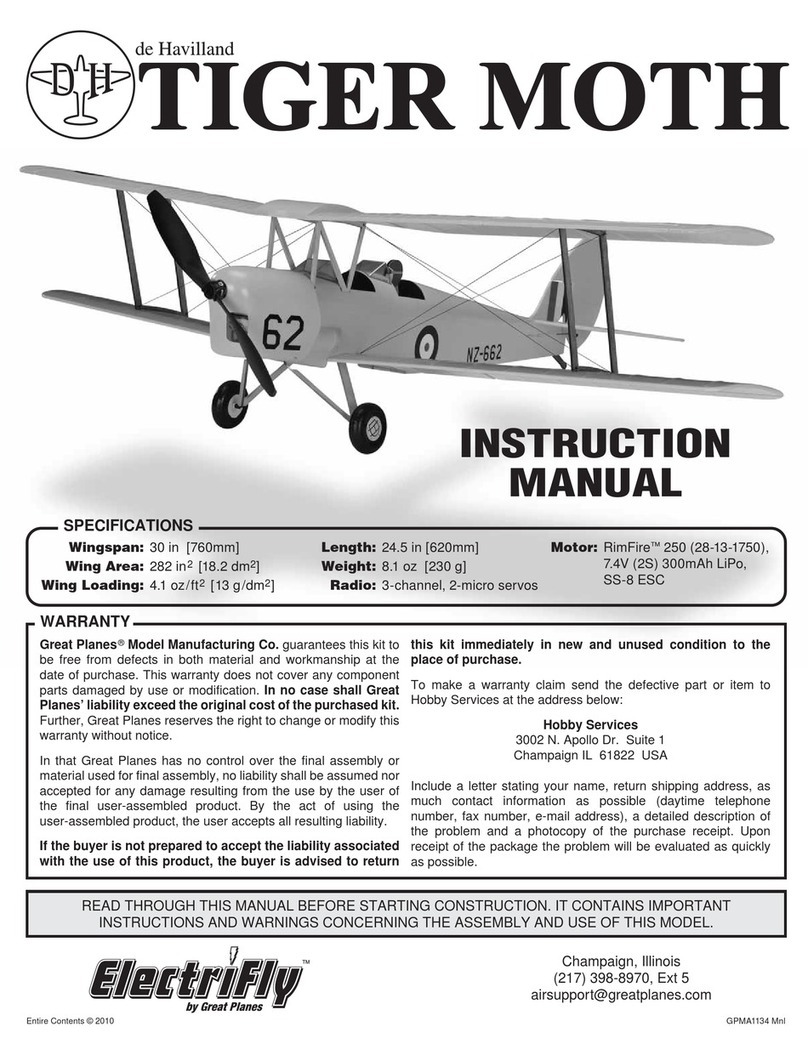
electrifly
electrifly Tiger Moth User manual
Popular Toy manuals by other brands

Pacific Aeromodel
Pacific Aeromodel 27 percentGee Bee "Y" ARF instruction manual
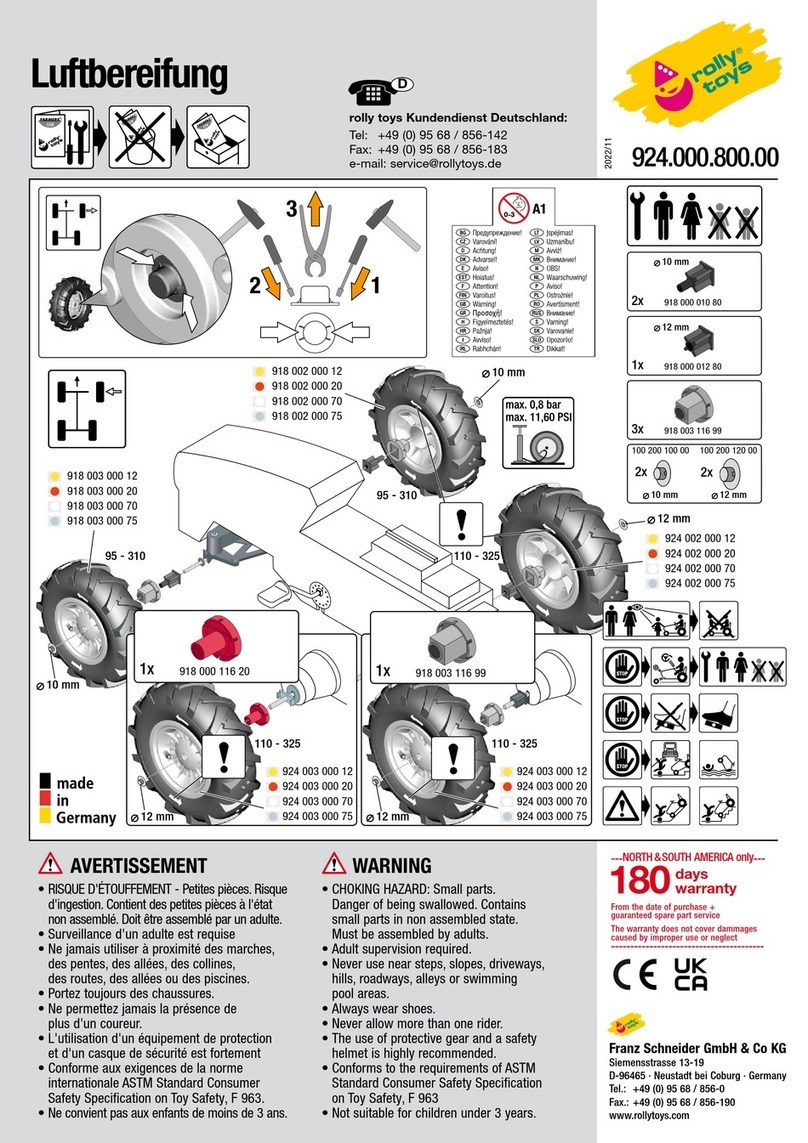
Rolly Toys
Rolly Toys 924.000.800.00 manual
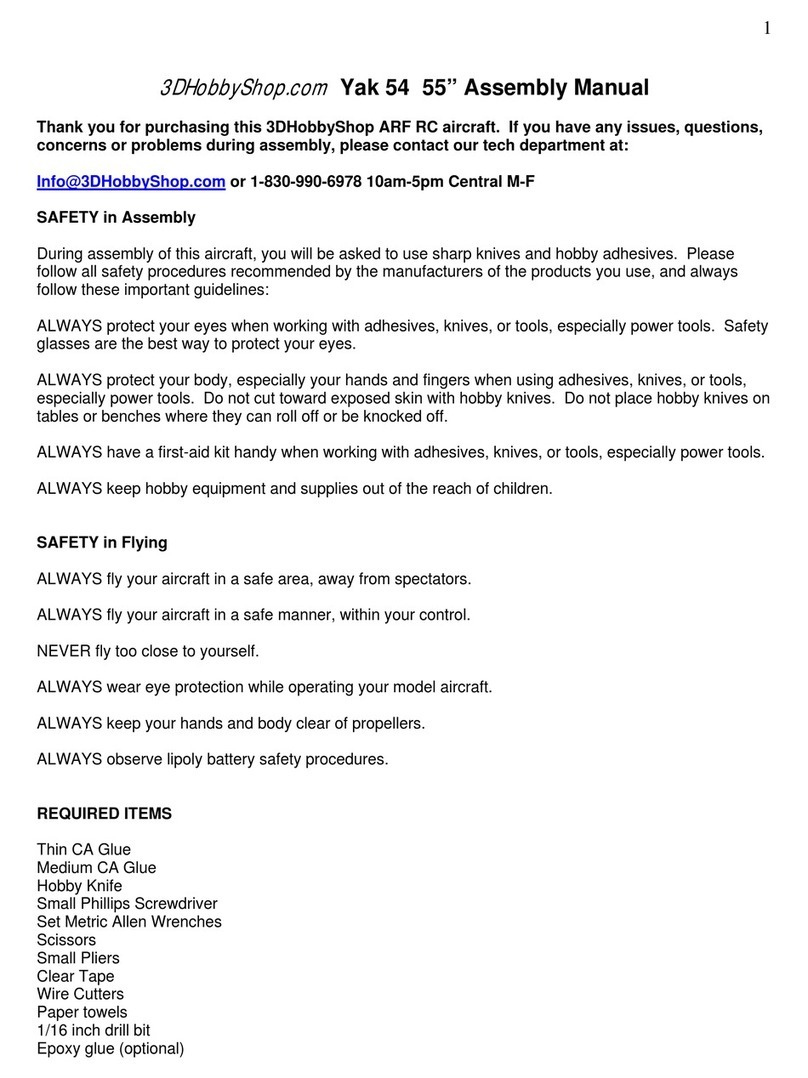
3DHobbyShop.com
3DHobbyShop.com Yak 54 Assembly manual

LEGO
LEGO STAR WARS 75094 Building instructions

Canon
Canon PaperCraft Halloween/Witch's Hat manual
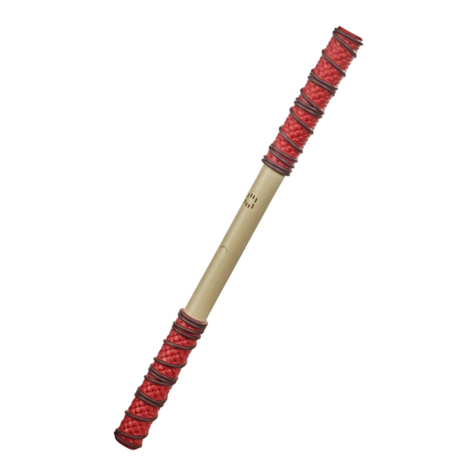
Marvel
Marvel SHANG-CHI and The Legend Of The Ten Rings manual

